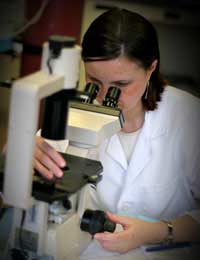Animal Suffering Categories: Mild

Animal testing is assessed according to several categories, which aim to gauge the level of animal suffering during animal experimentation. In the United Kingdom (UK), animal testing is strictly and consistently regulated. Therefore, potential animal suffering is assessed and project licenses are granted after consideration of the research aims and level of animal suffering involved in the experimentation. These licenses are subject to various conditions and require that those conducting the animal testing seek to minimise possible animal suffering and distress.
Mild Category
The mild category of animal testing classification is the lowest end of the animal suffering range that is considered when determining animal suffering. This particular severity involves procedures and applications that range from the taking of a single, small or infrequent sample - including blood and urine - to a minor change in the animal's diet. It may also involve a simple, minimally obtrusive surgical procedure such as a small, superficial biopsy. Where necessary, minor surgical procedures would, however, be performed under anaesthesia. The refinement approach for alternative animal testing methods is also observed to ensure that the level of suffering is reduced to mild whenever possible. Respect for this method ensures that animals do not suffer more than absolutely necessary to satisfy the goals and aims of scientific experiments. Within the UK, almost one half of experiments involving animal testing are classified as mild, although as improved alternative methods occur, this number will likely increase.
Criticisms of Animal Testing Assessments
One criticism of animal testing assessments stems from the belief that researchers are unable to accurately and sufficiently gauge an animal's level of suffering. Therefore, an animal could suffer distress or pain - sometimes significant - greater than initially projected. Other critics of the current system of classification cite that the system simply isn't specific enough. Instead, they argue that a wider range of classification categories should be used when determining the likely level of animal suffering. They also argue that it would be preferable, in part, because researchers are obtaining a more detailed classification prior to experimentation even commencing, which allows for an appropriate project license to be granted.
With the current small number of categories for assessment, poor classification could mean that a project license is granted based on inaccurate information when instead, a license may have otherwise been turned down. Another criticism of the classification system is that the level of suffering can vary greatly throughout an experiment. Thus, the current system is considered not advanced enough to appease the demands of today's testing structures. Still other critics feel that the entire system of classifying animals only prior to experimentation is a poorly structured one because it only relies on projected levels of suffering. They argue that it is no better than an educated 'guess' that could result in higher than projected levels of animal suffering. The alternative here would be a two-phased classification system where animal suffering is projected prior to experimentation and then again after a license is granted and during animal testing itself.
Keeping Most Projects in the Mild Assessment
While all of this additional assessment and monitoring would place a larger burden on scientists involved in animal testing, it would mean that animal care is improved and that animal testing itself becomes more transparent overall. Ultimately, whether you support animal testing or are against it, the reality is that animal testing does occur. At the very minimum, animal welfare should be maximised at all times. The current classification system is a step in the right direction but will hopefully be improved in the future. Alternative methods such as refinement procedures will also ideally make the mild category the largest one, which means a lower level of animal suffering or distress.


Re: Food Production and Animal Testing
You would have to grow the food yourself and not use pesticides. Industrially farmed veg is sprayed with pesticides which…
Re: Using Animals for Testing: Pros Versus Cons
Do they animal test on chimpanzees cause DNA?
Re: Who Performs Animal Testing?
Animal Testing and Experimenting is most Barbaric. 96% of all the results fail, and can't be used on Humans. A hundred and fifteen…
Re: Using Animals for Testing: Pros Versus Cons
While some animal testing is not ok you also have to look at the bright side of this. Because of animal…
Re: Biomedical Research and Animal Testing
Animals don’t have much of a life than humans they also have a shorter time span than humans
Re: What Happens to Animals After Testing?
In 2004, the FDA estimated that 92 percent of drugs that pass preclinical tests, including “pivotal” animal tests,…
Re: What Happens to Animals After Testing?
I entirely disagree with all animal experiments. They are archaic and hideously cruel. They cannot express pain like…
Re: Who Performs Animal Testing?
In regards to animal testing by the MoD medical equipment mainly field dressings and celox gauze is tested on live animals that…
Re: What Happens to Animals After Testing?
Is animal testing inhumane and cruel? Of course. But for example, let's say that someone has diabetes and the only…
Re: Animal Testing in the United States
I have degrees in chemistry and physics and have done cancer research before in the U.S. but stopped because drugs…